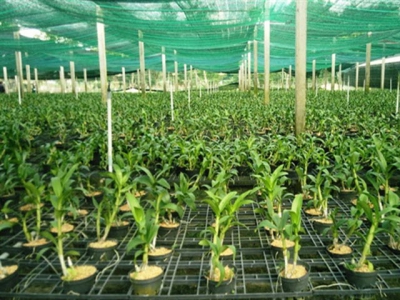Ho Chi Minh City to build plant variety, animal breeding centres

Ho Chi Minh City — Farmers and experts have asked HCM City authorities to remove hindrances and create favourable conditions for residents to build greenhouses and breeding centres on agricultural land used to build nursery gardens.
A greenhouse at the Hi-tech Agricultural Park in HCM City’s Củ Chi District. — VNS File Photo
Dư Huy Quang, head of land management division under the HCM City Department of Mineral Resources and Environment, said the Land Law of Việt Nam allows building of agricultural support facilities such as glasshouses and greenhouses on agricultural land typically used to build nursery gardens.
However, farmers faced challenges in transferring land-use purposes, Quang said at a seminar held by HCM City People’s Council and HTV on July 19.
According to Phạm Kim Bằng, manager at the Business Licensing Division under the HCM City Department of Construction, the Construction Department has drafted instructions on construction of agricultural support facilities, which includes two categories of construction works.
The first category includes works that provide nets and favourable conditions for plant varieties and breeding animals. Construction of these works, which use removable materials, must be reported to commune People’s Committees.
Sentry boxes at these nursery gardens must be built with environmentally friendly materials such as trees and thatch. They must have one storey and be under 15m wide and 6m high, with total area of less than 1,000 sq.m.
Sustainable development
According to figures released by the HCM City Department of Agriculture and Rural Development, the city has about 114,000 ha of agricultural land, nearly half of the city’s total land area. It includes about 66,000ha for agricultural production; 35,684 ha for silviculture; and 10,798 ha for aquaculture. The city also has more than 25,300 farming households.
Dương Đức Trọng, deputy director of HCM City Department of Agriculture and Rural Development, said after nearly 10 years’ operation of the city’s urban agricultural development project, the areas under hi-tech agricultural production had been expanded.
The per capita income of these farmers rose from VNĐ25 million (over US$1,090) per year in 2011 to VNĐ63 million in 2019, Trọng said.
The city has 130 agricultural cooperatives and is expected to build two to three hi-tech agricultural zones with expected revenues of VNĐ900 million for each ha of land, and projected per capita income of VNĐ100 million (US$4,291) for residents in rural areas, according to Trọng.
Đinh Minh Hiệp, head of the management board of the HCM City’s Hi-tech Agricultural Park, said that urban agriculture would be developed with a modern concept of sustainable development, with a focus on the use of hi-tech industries and bio-technologies.
Hiệp said the city would build centres for plant varieties and animal breeding which would be provided to southern provinces in Việt Nam and neighbouring countries including Cambodia, Laos and Thailand.
Có thể bạn quan tâm
 Vĩnh Long expands frog-red tilapia polyculture farms
Vĩnh Long expands frog-red tilapia polyculture farms Vĩnh Long’s Agriculture Extension Center has farmed commercial frogs with red tilapia in a pond raceway system economically and commensurately to farming skills
 Kiên Giang - Build a large field of shrimp-rice
Kiên Giang - Build a large field of shrimp-rice The project aims to build a large field which meets standards of scale and synchronous technical appliances, and produces high yield with high quality.
 Vietnamese green mango exports to Australia double
Vietnamese green mango exports to Australia double Figures released by the Australian Department of Agriculture revealed that exports of Vietnamese green mangoes to Australia doubled year-on-year